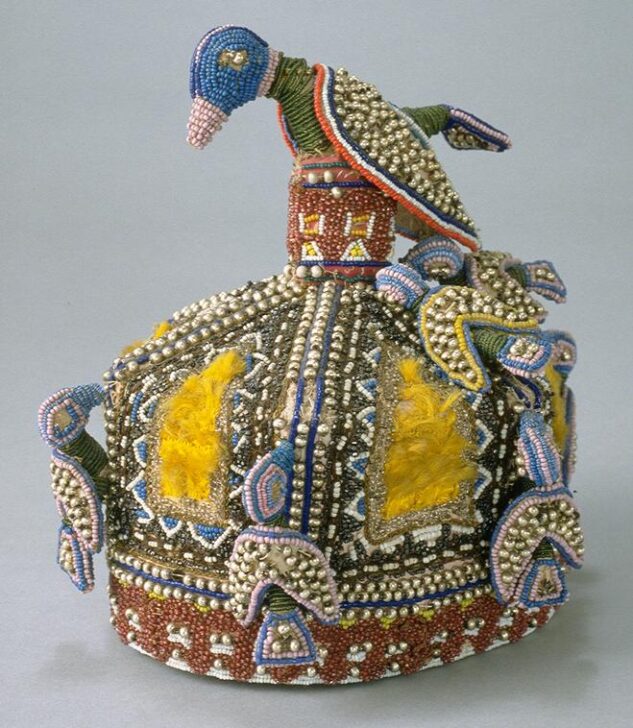Beaded Coronet
Yoruba

Description
March 28, 2009
This coronet is a Yoruba ruler’s everyday headgear. Because a ruler’s source of political authority and identity resides in his inner, “spiritual” head, his visible head must be covered at all times.
In the nineteenth century, European seed-beads became incorporated into Yoruba regalia and broadened the range of colors used. This coronet’s design also testifies to the connection between Yorùbáland and Europe: its appearance recalls jewel-encrusted imperial crowns worn by English royalty. The contrasting colors and textural shifts on this coronet express Yoruba aesthetics of character and beauty. The combination of yellow and green represents tranquility and restraint. Thickly beaded strips radiate from a red perch upon which sits a gold-winged egret, keeper of culture and leader of all birds.
Subject Matter:
As the ori inu—inner head—of an oba—sacred king—possessed great power, his physical head (ori ode) needed to stay covered. Part of the beaded regalia that came about with the arrival of colonialism was a form of headgear known as oríkògbòfó, meaning “the head must not be bare”. Prior to the mid-nineteenth century, oba did not leave the palace except for important ritual events. But with the need to meet with other oba and foreigners, oba began wearing such caps or coronets in various forms. Oríkògbòfó in the form of British crowns were a common design, which developed at the beginning of the 20th century, especially during the period of British colonial control. Birds were also a common feature in an oba’s beaded regalia, which referred to okin, known as the “king of birds” as well as the mystical power of women, known as awon iya wa, “our mothers”.
References:
Pemberton, African Beaded Art: Power and Adornment, 2008
Lawal, Visions of Africa: Yoruba, 2012
Drewal, Yoruba: Nine Centuries of African Art and Thought, 1989
Physical Description:
Round beaded crown with six radiating bands—predominantly green with white, metallic and blue accents—that stem from the central axis upon which a large blue-headed bird sits. Eight smaller birds perch at the base of the bands. The bottom rim is predominantly red with white, metallic, and blue accents. The spaces in between the vertical bands are filled with yellow feathers.
Usage Rights:
If you are interested in using an image for a publication, please visit https://umma.umich.edu/request-image/ for more information and to fill out the online Image Rights and Reproductions Request Form.